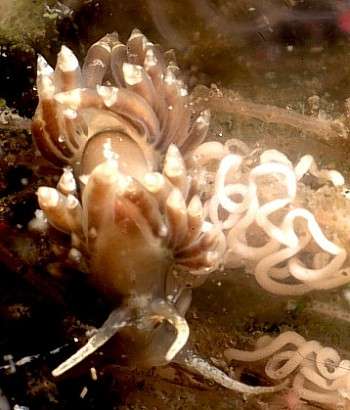
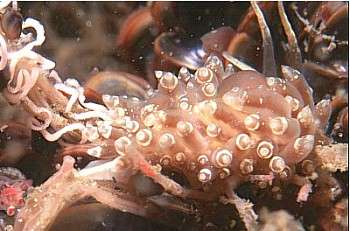
Cratena? pilata
(Gould, 1870)
Order: NUDIBRANCHIA
Suborder: AEOLIDINA
Family: Glaucidae
DISTRIBUTION
West Atlantic from Sao Paulo, Brazil to New England (Marcus, 1977).
PHOTO
off Long Island, New York, USA., The depth approx 20 feet (6 meters). PHOTOS: Betsey Hansen.
See Betsey Hansen's message and Terry Gosliner's message below.
Reference:
• Marcus, Ev. (1977). Annotated Checklist of the Western Atlantic Warm Water Opisthobranchs. Journal of Molluscan Studies, Supplement 4., 22pp.
Related messages
Re: Aeolid from New York
December 15, 2006
From: Anthony Fernando
Concerning message #1142:
Hi Dr. Rudman,
I recently found this short paper by Dr. Franz:
-
Franz, D. R. (1968) Taxonomy of the eolid nudibranch Cratena pilata (Gould) Chesapeake Science, 9: 264-266.
Apparently the revision of C. pilata was already considered. From the paper: "Unfortunately, the name Cratena has been frquently misapplied, even by Bergh himself, who included in it various species of cuthonid nudibranchs. The error was compounded by Iredale and O'Donoghue (1923), who misinterpreted Cratena as a synonym of Montagua, Fleming, 1821 with Doris coerulea Montagu, 1804 - a cuthonid- as type. Consequently, Cratena has been considered a cuthonid genus by most subsequent authors. The situation has happily been rectified by Macnae (1954) and the proper generic placement of C. pilata is Cratena, Bergh, 1864 a favorinid, not Cratena (Bergh, 1885; auctt. non Bergh), a cuthonid." (Franz, 1968)
-
Macnae, E (1954) On some eolidacean nudibranchiate molluscs from South Africa. Annals Natal Mus. 23:1-51.
-
Iredale, T. And C. R. O'Donoghue (1923) List of British nudibranchiate mollusca. Proc. Malac. Soc. Lond. 15:195-200.
That's not to say that there's not a later revision that I'm not aware of, of course. I'm just barely getting started to the literature for the West Atlantic.
Tony Fernando
anthonyfernando@yahoo.com
Fernando, A.V., 2006 (Dec 15) Re: Aeolid from New York. [Message in] Sea Slug Forum. Australian Museum, Sydney. Available from http://www.seaslugforum.net/find/19019Dear Tony,
Thanks for the reference. What we were saying is that 'Cratena' seems to be the best fit at the moment. The aeolid genera are still in need of some love and attention. For example I lump a lot of genera into the Glaucidae while other workers consider that many of these genera should be separated into the Phidianidae and Facelinidae, and even the Favorinidae.
It was a lot simpler when Gould described the species - at that time most authors placed all aeolids into the genus Aeolis. One of the great values of the binomial [two names] naming system we use for species is that the name reflects the evolutionary relationships of the species. The great drawback is that as out understanding of those relationships change, the names - or at least the first of the two names - often has to change as well.
Best wishes,
Bill Rudman
Cratena pilata from North Carolina, USA
December 4, 2006
From: Tony Fernando
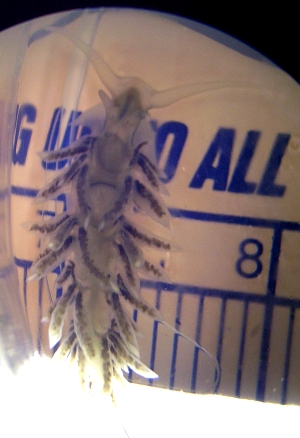
Concerning message #1130:
Hello Dr. Rudman,
We recently have collected upwards of 20 specimens of Cratena pilata. The initial specimens were collected from the side of an upweller receiving raw-seawater. We have also collected this species when we raised out of the water for cleaning a strainer that feeds our flow through system. Dr. Miller at the University of Auckland very patiently helped us with the identification.
Locality: Morehead City, 0-6m, North Carolina, USA, Bogue Sound, 1-29 November 2006. Length: 8-24mm. Photographer: Tony Fernando and Janet Hanson.
I am providing this from my notes since the forum page for this species is a little sparse. The species has been collected here in several locations before. (Wilson, 1979)
General: Specimens ranged from 8 mm to 24 mm long. The body is generally translucent, though some specimens had reddish or brown spots of pigment, especially between the rhinopores. The rhinopores are "rough" (I don't know the correct term, they are not simple, and do not have rings or branching) Some specimens had a band of brown pigments midway on the rhinopore. Oral tentacles are longer than the rhinopores, on undamaged specimens they could be up to 2x longer than than the rhinopores.
Cerata were generally clear (1 specimen had the gold flecking seen in the pictures in message #1130 ). Cerata contain a green branching digestive gland and a white-to-clear terminal sac. Cerata are arranged in arches along the side of the body. Larger specimens had 6 arches, smaller ones 5. The largest cerrata in each arch are at the apex of the arch, small and budding cerrata are at the two endpoints. The genital aperture is located forward of the leading tip of the first arch on the right side. The anus is located in the center of the second arch, also on the right side.
Eggs and Larvae: Eggs are laid in a ribbon of capsules, with one egg per capsule. Ribbons were laid on glass, plastic, hydroids, and bryzoans. When laid on glass, the eggs were generally deposited in a spiral, though ragged lines were also observed. Eggs hatch in 4 days when maintained in standing seawater at room temperature. Size at hatching is 100 micron measured accross the shell. Hatched larvae feed readilly on Isochrysis galbana, by creating a current with their cillia that draws the algae to their mouth. We have not sucessfully cultured the larvae to metamorphosis.
When isolated, C. pilata over 12 mm generally laid eggs within 48 hrs of isolation. Specimens under 12 mm never did.
Adult feeding: Adult specimens were observed feeding on hydroids. Fecal analysis showed several local diatoms intermixed in the fecal matter. I don't know if that means the animal is eating the biofilm off the hydroid or the hydroid itself and ingesting the diatoms in the process.
-
Wilson, W. H.. (1979) An Annotated Checklist of the Shallow-water Marine Invertebrates of the Morehead city-Beaufort Region of North Carolina. (C.H. Preston, Ed.). Morehead City: University of North Carolina Institute of Marine Sciences
Sincerely,
Tony Fernando
Student
Department of Applied Marine Science
Carteret Community College
Morehead City, NC, USA
anthonyfernando@yahoo.com
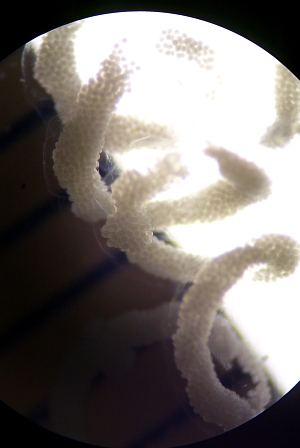
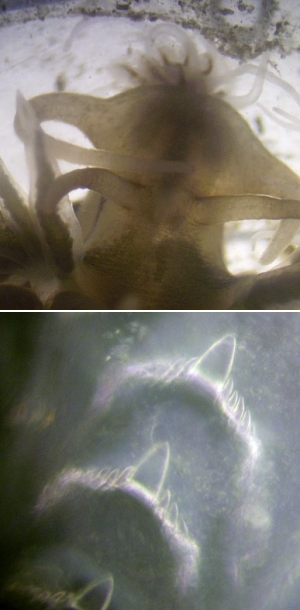
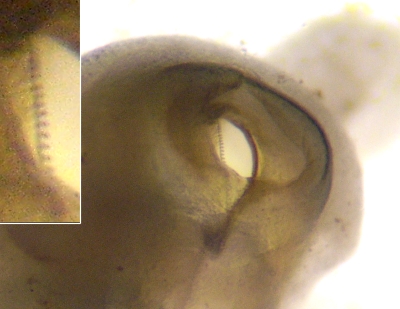
Dear Tony,
Thanks for this detailed information. You are right in thinking the Fact Sheet for this species is a bit sparse. It is surprising how little readily available information is available on the opisthobranch fauna of the temperate region of the Nth American east coast. The only general source I know is Sherman Bleakney's book for Canada and the Gulf of Maine. This species is a good example, well illustrating Terry Gosliner's comment [#1142] that 'many of the common species in New England are in need of taxonomic revision'.
I like the photo of the mouth showing the serrated edge of one of the jaw plates.
-
Bleakney, J.S. (1996) Sea Slugs of Atlantic Canada and the Gulf of Maine
Best wishes,
Bill Rudman
Aeolid from New York
July 31, 1999
From: Betsey Hansen


Bill,
The attached slides were taken in the northwestern Atlantic Ocean just off the coast of Long Island New York. The depth was about 20 feet (6 meters). There were two of these Nudibranchs in the area on hydroids. One of the shots shows their eggs. I think it is a Coryphella, but I have not been able to identify the species. The records for Northern Atlantic nudibranchs are very limited.
Best wishes,
Betsey
Elizabeth.P.Hansen@chase.com
Hansen, E.P., 1999 (Jul 31) Aeolid from New York. [Message in] Sea Slug Forum. Australian Museum, Sydney. Available from http://www.seaslugforum.net/find/1130Dear Betsey,
Rather than make a guess I will leave it to someone else to help us out. I can't really estimate its size, but if I was making a guess I would say a Cuthona or a related genus. Can someone with a knowledge of the fauna of the US east coast come to our aid please.
Best wishes,
Bill Rudman.
Re: Aeolid from New York
July 31, 1999
From: Terry Gosliner
Dear Bill,
The aeolid is indeed an old friend, from my days in New Hampshire. It is Cratena pilata. Marcus first placed it in Cratena. It is probably a Sakuraeolis or something like that based on the penial glands that are found in that species. It certainly is not a Cratena. Even many of the common species in New England are in need of taxonomic revision.
All the best,
Terry.
tgosline@calacademy.org
Gosliner, T.M., 1999 (Jul 31) Re: Aeolid from New York. [Message in] Sea Slug Forum. Australian Museum, Sydney. Available from http://www.seaslugforum.net/find/1142